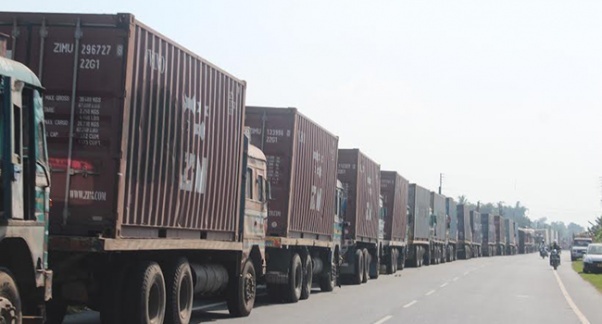 KATHMANDU, Feb. 8 (Nepal Foreign Affairs)–Vehicles passed through the main border point of Birgunj between Nepal and India on Friday, 5th February, after locals and businesspersons in large number forcefully removed barriers set up by Madhesi protesters. This marked an end of the blockade that was in place for 135 days, since September 21, 2015.
KATHMANDU, Feb. 8 (Nepal Foreign Affairs)–Vehicles passed through the main border point of Birgunj between Nepal and India on Friday, 5th February, after locals and businesspersons in large number forcefully removed barriers set up by Madhesi protesters. This marked an end of the blockade that was in place for 135 days, since September 21, 2015.
Sudden turn of events
This was a sudden turn of events for people who don’t know what was going on internally. As the blockade and strike continued for months, it was the residents and locals who suffered the most at the lack of fuel and cooking gas. Sensing an opportunity, the government appears to have mobilized several plain cloth police to create a counter-narrative which evolved into locally led “Save Birgunj Campaign”. Though nascent and not discussed much, the objective of this campaign was to establish that Birgunj was a dying city because of the strike which would in turn develop other cities in border areas at the expense of Birgunj. This ultimately paid off. Businesspersons in both Nepalese as well as the Indian side took the lead to open the border blockade. The anger of losing business has now fallen on the leaders of agitating parties. This has actually eroded the credibility of Madhesi parties and has brought success to the government strategy.
On January 23, much awaited amendment of the new constitution of Nepal took place which addressed two key demands of Madhesi agitation: proportional inclusion and creation of election constituencies in proportion to population. India, who was tacitly supporting the agitation, realized that the amendment has addressed major concerns. Issue of state borders would take time since India itself is creating new states even after sixty years of federalism. So, it wanted normal operation of the borders right after the amendment.
India was somehow convinced with the proposal of Nepal government which was discussed twice with Nepal’s Foreign Minister Kamal Thapa, with confidence of Prime Minister KP Sharma Oli. As promised, Nepal has amended the constitution. In return, India’s current establishment led by BJP appears to have made up its mind to do business with KP Sharma Oli, at least for now, and is preparing to welcome him in India from 19th February. Dates are yet to be officially announced, but the visit is confirmed.
Major wing of the agitating parties, the United Democratic Madhesi Front (UDMF), is a coalition of groups which are competing for influence in the plains region. After India softened its stance on blockade followed by constitution amendment, UDMF was under pressure to announce the end of its blockade program. But the parties in UDMF started competing for credit of ending the blockade.
Birgunj blockade was under responsibility of Sadbhawana Party leader Rajendra Mahato. He publicly announced, before a collective decision of UDMF, that the borders should open. This was sufficient to trigger internal feud inside UDMF. The meeting which was scheduled to take place last week to decide ending the blockade has not taken place yet. Because the heads of the parties in UDMF competed to claim the credit of the movement, they got none and seem to have further discredited.
Implications for future
The way the blockade has ended actually marks a tragic story for UDMF and its constituent parties. Until a week ago, the group was poised to make big political gains since people believed that it was UDMF which would work for the people of Madhes. But multiple political miscalculations on their part seem to have further discredited them at this point. They didn’t take the ownership the constitution amendment. Neither could they claim that the blockade was lifted keeping in mind the suffering of the people. Just a month ago, thousands of people took to the street when these parties called; now, not even a hundred were ready to restart Birgunj blockade.
However, the erosion of the moderate political force like what UDMF is, the danger of radicalization in Madhes region exists. This could be used by nascent separatism in the region in the long run, although in the shorter term, separatism has also failed to make significant inroads even during the peak of Madhes movement. One thing is sure, without support from Kathmandu or New Delhi, or Patna, no kind of political movement can ever sustain on its own in Madhes.
This debacle must also give a lesson to the politicians: you cannot take people’s wisdom for granted; you cannot fool all the people all the time. Yes, there will always be a section to say, “ Oh, yeah, Madhes will go down the drain now because the causes of the movement are yet to be addressed”. They said so for the Maoists, they will say it again and again. What they should know is that instead of adding to injuries of a divided society, efforts of unity has to be made together.
Further, the state has announced 5 bn rupees development programme aimed at the eight districts of province 2, the hotbed of the agitation. This is in response to the discontent in the region, to prevent radical forces from using the unfulfilled aspirations of federalism and inclusion. More is expected from the government.

